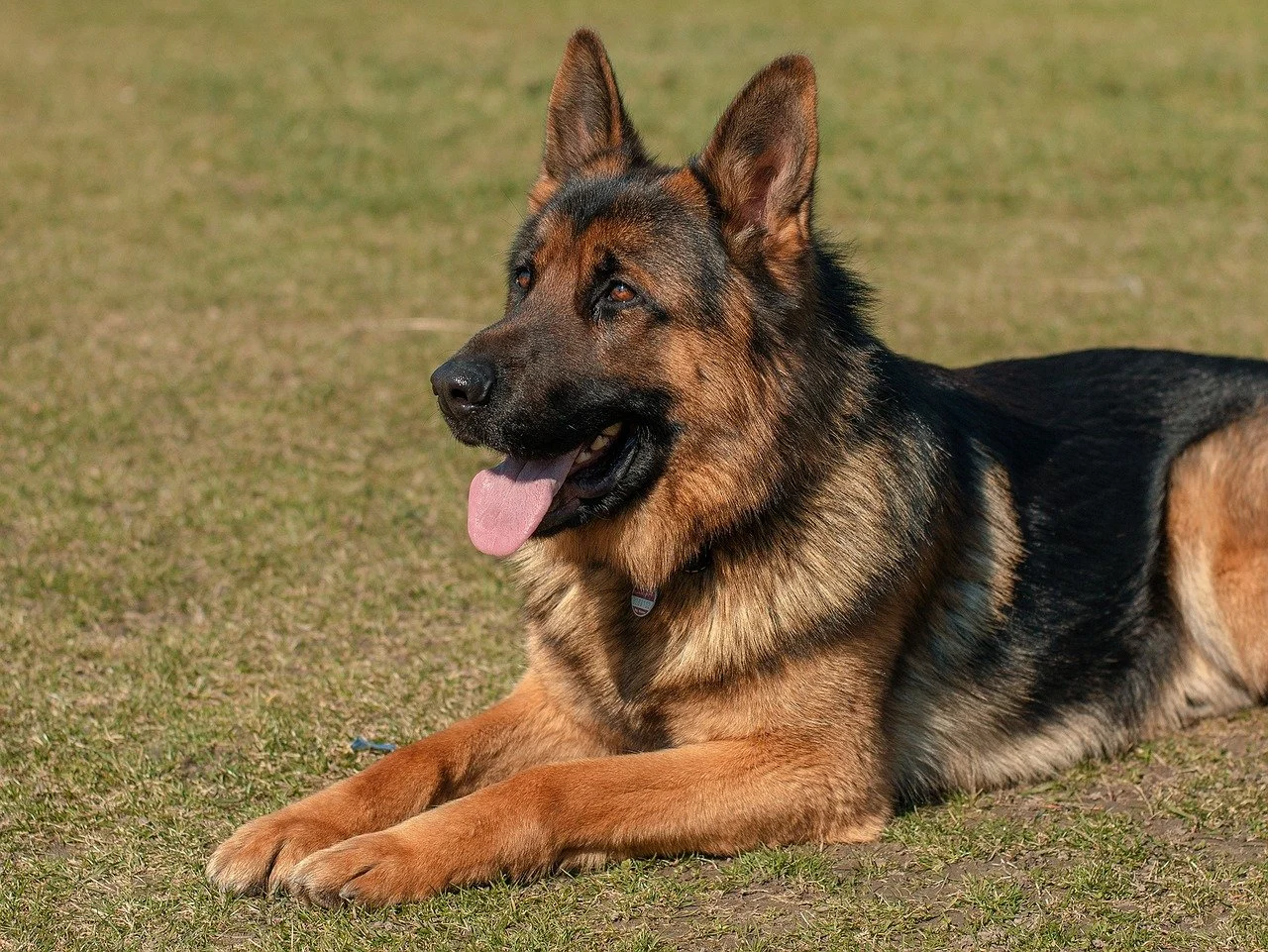There aren’t many dog breeds that are known and loved across the world as the Pastor Aleman or German Shepherd. Everyone knows how they look like thanks to dog movie star Rin Tin Tin. German Shepherds are all-around dogs, with great nature and are very smart.
German Shepherds aren‘t only part of pop culture through Hollywood movies and TV shows. They have also served and proved their worth as army dogs, police dogs, and were part of many search and rescue operations. On top of all that, German Shepherds make good watchdogs, family dogs, and even therapy dogs. Because this is a purebred breed they are also accepted by the American Kennel Club. These dogs are also accepted by all-breed clubs in the United Kingdom. You can also register your German Shepherd in the German Shepherd dog club of America.
But where do these dogs come from, are they really from Germany and who was the breeder that developed them? Besides that, what else is there to know about these dogs?
In this article, we will go into more details on this breed, what they are like, where they come from if they are healthy dogs, and so on.
Read more about other dog breeds and mixes:
- German Shepherd Corgi Mix
- Pitbull and Rottweiler Mix: Strong And Clever
- Golden Retriever Husky Mix: The great Goberian
- Vizsla Dog Breed Info: Info, Facts And Characteristics
- Cane Corso: The good and the bad
- German Shepherd Golden Retriever Mix: The fun dog
- Shetland Sheepdog Breed: What You Have To Know
Pastor Aleman or German Shepherd history
The history of the German Shepherd or Pastor Aleman is very interesting. The German Shepherd is a relatively new breed, having been developed in 1899 by Commander Max von Stephanitz. Von Stephanitz was a career captain in the German cavalry, and when developing the German Shepherd he had only one goal in mind, creating a German breed that would be unrivaled as a herding dog.
Farmers in Germany, as well as the rest of Europe, relied on dogs to drive and defend their cattle for centuries before captain Max von Stephanitz arrived. Sheepherders would travel for days to breed their female dogs to a prominent sire, and certain dogs were legendary for their skill. However, as von Stephanitz pointed out, no one had developed the region’s herding dogs into a separate breed.
In 1898, Von Stephanitz left the military and began his second career, and what would become his passion, experimenting with dog breeding to create a superior German herding dog. Stephanitz studied British breeding methods, which are known for generating superb herding dogs, and toured Germany, attending dog shows and witnessing German-type herding dogs.
The wolf-like dog
Von Stephanitz observed many good herding dogs who were athletic, intelligent, and capable. What he didn’t see was a dog with all of those features.
In 1899, Von Stephanitz was at a dog show when he observed a wolf-like dog. He immediately purchased the dog, named Hektor Linksrhein. The dog’s powerful build and intelligence so impressed von Stephanitz that he established the Verein für Deutsche Schaferhunde to establish a breed from Horand’s progeny.
Although von Stephanitz intended for his breed to be used as herding dogs, he witnessed a decline in demand for such dogs as Germany became more industrialized. He was determined that his breed would continue to be used as a working dog, and he decided that the dog’s future would be in law enforcement and military service dogs.
Von Stephanitz persuaded the German government to use the breed by using his military links. During World War I, the German Shepherd acted as a Red Cross dog, courier, savior, guard, supply bearer, and sentry.
Breed’s name
According to Wikipedia Von Stephanitz named the breed Deutscher Schäferhund, which translates to “German Shepherd Dog.” The name derives from the breed’s traditional duty of assisting shepherds in herding and protecting sheep. All other herding dogs in Germany at the time were referred to by this term, and they were known as Altdeutsche Schäferhunde or Old German herding dogs.
The exact translation of the name was adopted for use in the official breed registry; but, near the close of World War I, it was considered that including the term “German” would harm the breed’s reputation due to anti-German sentiment at the time. The breed was formally called “Alsatian Wolf Dog” by the UK Kennel Club after the French region of Alsace, which borders Germany.
The appendage “wolf dog” was later removed after many campaigns by breeders concerned that being classified as a wolf-dog hybrid would affect the breed’s popularity and legitimacy. The name Alsatian remained in use for five decades, until 1977, when significant campaigns by dog aficionados persuaded British kennel clubs to reclassify the breed like German Shepherds. The word “Alsatian” used to be included in parenthesis as part of the formal breed name, but it was removed in 2010.
German Shepherds in the United States
Although German Shepherds were introduced to the United States before the war, it wasn’t until the war that the breed acquired popularity. The dog’s bravery and intelligence were lauded by Allied personnel, and several canines were sent home with these warriors.
A Los Angeles-based American corporal rescued a five-day-old puppy from a bomb-infested kennel in France. The corporal took the puppy home, trained him, and turned him into one of Hollywood’s most famous four-legged stars: Rin Tin Tin, who appeared in 26 films and helped popularize the breed in the United States.
Although the Allies were enthralled by the German canines, they were not enthralled by the dog’s German pedigree. Because everything German was demonized during the war, the American Kennel Club (AKC) renamed the breed Shepherd Dog in 1917.
Pastor Aleman in the UK
In England, the dog was known as the Alsatian Wolf Dog, after the German-French border region of Alsace-Lorraine. The American Kennel Club restored the traditional name of German Shepherd Dog in 1931, but the British Kennel Club did not until 1977.
Von Stephanitz remained deeply involved in the breed’s history, and as early as 1922, he was concerned about some of the dogs’ growing characteristics, such as poor temperament and a predisposition for tooth rot. Before being bred, each German Shepherd has to pass a battery of IQ, temperament, athleticism, and health tests.
German Shepherd breeding in the United States, on the other hand, was not nearly as rigorously regulated. In the United States, the dogs were bred to win dog shows, and breeders paid more attention to the dogs’ beauty as well as their gait, or way of moving.
American-bred German Shepherds and German-bred German Shepherds began to diverge dramatically after WWII. Because native German Shepherds were failing performance tests and suffering from hereditary health problems, the United States police and military began importing German Shepherd working canines.
In recent decades, several American breeders have decided to refocus on the breed’s talents rather than its beauty, importing working dogs from Germany to supplement their breeding program.
American vs German Bloodline
As already mentioned, American soldiers brought German Shepherds into the USA after WWI. But, breeding practices were not good nor were they regulated. The focus of the breeding practices in Germany was to develop a healthy working dog. But, the focus of the breeders in the USA was to develop a dog to win shows.
As a consequence, American and German or European lines of German Shepherds began to differ dramatically. German bloodline was a healthy, energetic, working dog and for doing police work, while American bloodline was more about appearance.
But what were the differences between these two varieties?
Differences in appearance
The appearance of the American and European German Shepherd is the most evident distinction. The American is the largest of the two, with a longer body. His back end slopes more than the European’s, but the European has a much straighter topline. American German Shepherds have bigger bones and weigh slightly more than European German Shepherds.
The American German Shepherd has a smaller and rounder head than the European German Shepherd, which has a larger and more angular head. Many people liken the European’s head to a wolf’s.
The length and texture of their coats are the same, although either line may have a shorter or longer coat. Their most typical coat colors are black and tan, however, they can both inherit more unusual German Shepherd colors including full black, white, and, in rare circumstances, blue. The only difference is that the American German Shepherd is often lighter in color.
Temperament
In terms of personality, the main difference between the American German Shepherd and the European German Shepherd is that the European variety is generally happy when working. This is most likely owing to their purposeful development as working dogs in both the protection and herding industries. In comparison to the European German Shepherd, who is now more commonly found as a family pet, the American is not put to as much testing.
If you want a working dog, you should engage with a European German Shepherd breeder rather than a general German Shepherd breeder. The American German Shepherd, on the other hand, is a better choice if you merely want a German Shepherd to be a family pet. He is less protective and maybe a less aggressive breed variation if not properly exercised.
Because he is less work-oriented and protective, the American German Shepherd is less focused on his master or primary caregiver. Instead, he is much more laid-back and less intense with the whole family. Another reason why he might make a better family pet than a European German Shepherd.
Their personalities are practically identical in the remaining aspects. They both make great household watchdogs and guard dogs if necessary. Both American and European German Shepherds are apprehensive of strangers, and even if they do get to know someone, they will never be overly friendly. Both breeds are a lot of fun and enjoy cuddling up with their families in the evening.
German Shepherd or Pastor Aleman breed standard
We‘ve briefly covered the characteristics of both European and American German Shepherds. But now we will focus on the breed standard of the German Shepherd according to the American Kennel Club. We will cover their appearance, coat colors, temperament, and most common health issues.
Pastor Aleman appearance
German Shepherds are medium-sized dogs. Males stand between 24 and 26 inches, while females stand between 22 and 24 inches. The average weight of a German Shepherd is between 75 and 95 pounds.
He is a well-balanced canine. The broadhead smoothly tapers to a sharp nose. The ears are enormous and stand straight. The back is muscular and flat, with a bushy tail that slopes downward.
Their brow is domed, they have a large square-cut muzzle with powerful jaws, and they have a black nose. The eyes are dark and medium in size. The ears are enormous and stand straight, open in front, and parallel, however, they are frequently drawn back during movement. A German Shepherd has a long neck that is raised when excited and lowered when running or stalking.
German Shepherds are typically tan/black or red/black. The majority of color variants include black masks and black body patterns that range from a basic “saddle” to an entire “blanket.”
But, let‘s talk more about the coat colors of the German Shepherd.
Coat colors
German Shepherds have a medium-length double coat that acts as insulation and protects them from the elements. Dogs with double coats have two layers of fur a rough topcoat and a soft undercoat. These two coats develop independently and to different lengths. The soft undercoat develops significantly faster than the topcoat and is much shorter.
The German Shepherd comes in many different colors, even though Black and cream is the most common color. But the reality is that they are very versatile, to the point that even the white Shepherd exists.
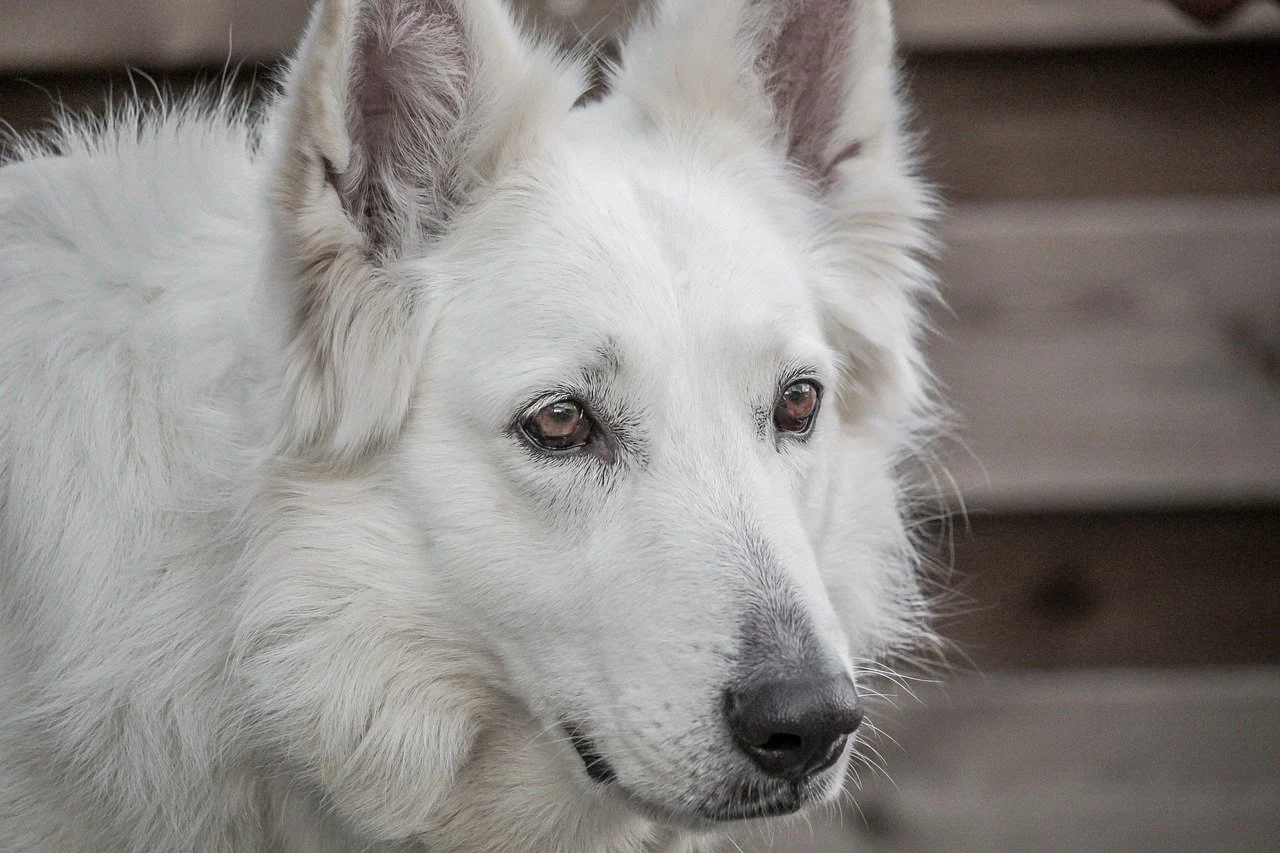
- Black and silver German Shepherd
- Liver German Shepherd
- Sable German Shepherd
- Black and tan German Shepherd
- Blue German Shepherd
- Grey German Shepherd
- Black and red German Shepherd
- White German Shepherd
- Black German Shepherd
- Black and cream German Shepherd
- Bi-Color German Shepherd
Most standards consider all-black and sable varieties to be acceptable; however, blue and liver are considered serious defects, and all-white is grounds for immediate disqualification from showing in conformation at All Breed and Specialty Shows.
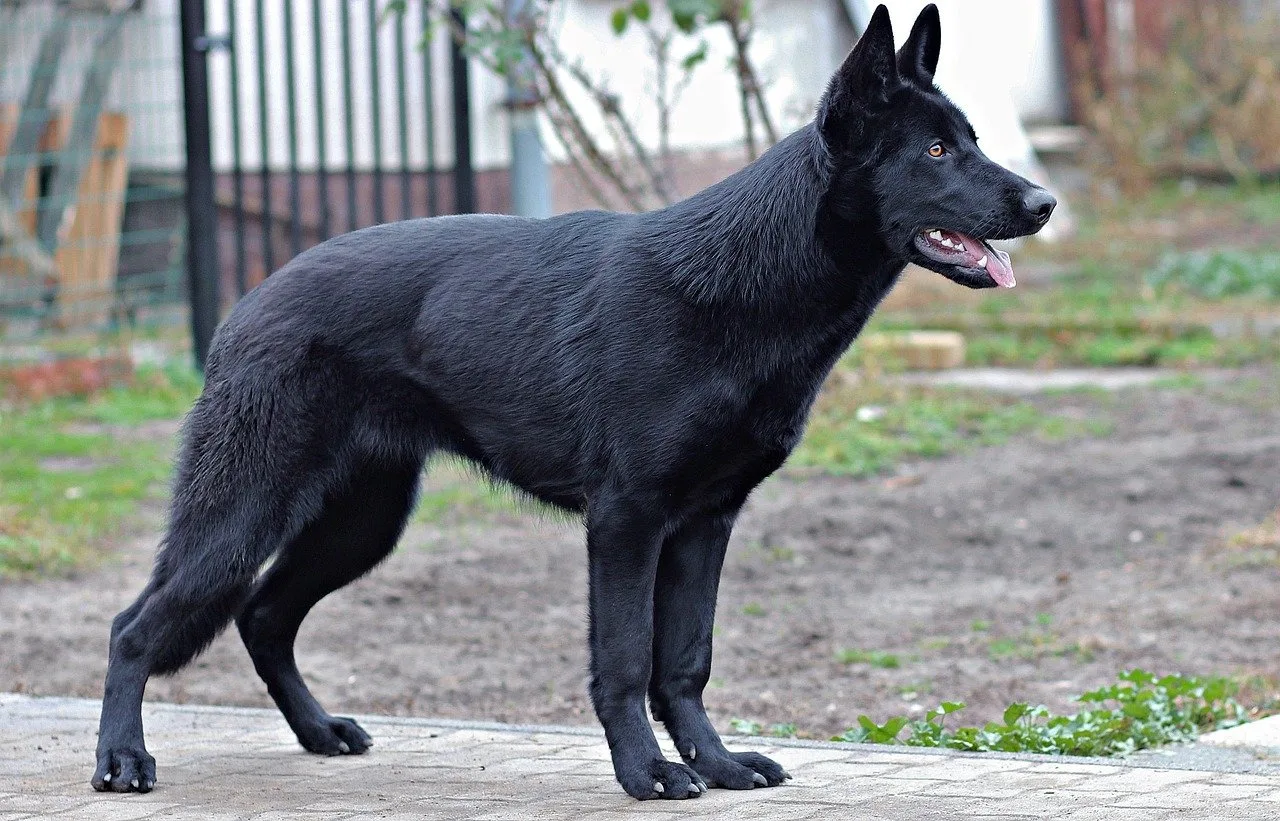
Personality
The typical Pastor Aleman is a cautious, reserved dog. So, they need time to become friends with strangers. But, when a German Shepard becomes your friend, you get the best companion for the rest of their life.
German Shepherds are loyal and protective. In case there is a threat to their home or family, they will do anything to protect them.
Also, a German Shepherd is an intelligent dog that can be trained to do almost anything. That’s why GS is the number one choice for militaries and police forces around the world.
Never leave your German Shepherd alone for long periods of time. They will become frustrated and bored and will likely develop separation anxiety and other behavioral issues such as chewing or barking.
Also, early socialization and exposure to other humans, dogs, and animals are the most important part of training a dog. That’s the only way your puppy will grow up into a well-behaved dog.
German shepherd dogs get along well with children and other pets if they are reared with them, but they are apprehensive of strangers due to their guarding instincts. The breed is said to be intelligent and easy to train.
Some German shepherd dogs that have been poorly bred might be nervous and high-strung. When combined with poor socialization and inadequate training, overprotection and aggressive behavior are causes for concern.
Health & Lifespan of the Pastor Aleman
German Shepherds are healthy dogs. But, like all dog breeds, they are susceptible to certain health issues and conditions.
The most common problems German Shepherds can develop health-wise are:
- A wide variety of allergies
- Hip Dysplasia
- Elbow Dysplasia
- Bloat (Gastric Dilatation-Volvulus)
- Exocrine Pancreatic Insufficiency (Genetic disease of the pancreas)
- Degenerative Myelopathy (Progressive disease of the spinal cord)
In the next section, we will take a closer look at all of the health problems German Shepherds can develop. A dog owner needs to be aware of all the health problems your dog might face. When you know about all the particular health problems of your dog and when you know all the symptoms of those health problems it will be easier for you to spot them and treat them on time.
The lifespan of Pastor Aleman is between 9 and 13 years.
Allergies
Allergies are unfortunately frequent in dogs of all breeds and origins. The majority of allergies emerge once a dog is six months old, with the majority of dogs affected being over the age of one or two.
An allergy is a condition in which the immune system overreacts or becomes hypersensitive to a specific substance known as an allergen. Proteins from plants, insects, animals, or foods are the most common allergies.
Allergens can be found in a wide range of substances. Although most allergies are caused by proteins from insects, plants, or animals, allergies can also be caused by tiny chemical molecules. Pollens, mold spores, dust mites, shed skin cells, insect proteins such as flea saliva, and various drugs are examples of common allergens.
The most typical sign of allergies in dogs is itching of the skin, which can be localized or broad. Coughing, sneezing, and/or wheezing are some of the symptoms that affect the respiratory system. There may be a runny discharge from the eyes or nose at times. In some circumstances, allergy symptoms wreak havoc on the digestive system, causing vomiting and diarrhea.
A dog may have numerous allergies, such as food allergies and atopy, making a precise diagnosis of a dog’s scratching difficult.
Allergies to foods
Almost any protein or carbohydrate component of food can cause a food allergy or hypersensitivity. Diet allergies in dogs are most usually caused by the protein in the food; dairy products, beef, wheat gluten, chicken, chicken eggs, lamb, and soy are all commonly linked to food allergies in dogs.
Food allergies can strike at any age. Itching, digestive problems, and respiratory discomfort are just a few of the clinical indications that can occur as a result of a food allergy.
Contact allergy
The least prevalent type of allergy in dogs is contact allergy. It is caused by direct contact with allergens such as pyrethrins found in flea collars, lawn insecticides, grasses, and textiles such as wool or synthetics used in carpets or mattresses, among others. At any age, contact allergies can develop into almost anything.
Skin irritation and itching at the places of contact, mainly the feet and stomach, will occur if the dog is allergic to any of these compounds. The problem is generally solved by removing the allergen (if it has been discovered).
Allergy to inhalants
Inhalant allergy is frequently used as a synonym for atopy in dogs. Tree pollens (cedar, ash, oak, etc.), grass pollens, weed pollens, molds, mildew, and home dust mites are the most common inhalant allergens. Many of these allergens, such as ragweed, cedar, and grass pollens, are seasonal.
Molds, mildew, and house dust mites, on the other hand, can be found all year. When humans inhale these allergens, upper respiratory symptoms such as runny eyes, runny nose, and sneezing are the most common symptoms.
Although allergic rhinitis or bronchitis are sometimes signs of allergies, most dogs’ inhalant allergies appear as itchy skin. The disorder is also known as inhalant allergic dermatitis because of these clinical symptoms. The dog may lick its feet, scratch its axillae, and rub its face.
Hip dysplasia
According to the Orthopedic Foundation of Animals, about 20 percent of German Shepherds have hip dysplasia. When a dog’s hip joint doesn’t grow the way it should, it has canine hip dysplasia. People who don’t grow at the same rate can make their hip joints very loose and unstable.
It can be hard for dogs with hip dysplasia to move around because when they have a loose hip joint, the structure of their joints might be permanently changed. Osteoarthritis can happen if you don’t get help for the condition (also known as a degenerative joint disease). People who irregularly move their bodies wear away cartilage and cause scar tissue and bone spurs to form.
Because canine hip dysplasia is a hereditary condition, it’s caused by how the animal was born. Large breed dogs are more likely to get the disease. If you are thinking about getting a Labrador retriever, you should know that large breeds are more likely to get it. But, not all dogs get this condition because of their genes. Experts say that puppies with a genetic predisposition to hip dysplasia are more likely to get the condition if they get more food than they need, which leads to faster than normal weight gain and growth. If your puppy does too much exercise, this can also be a risk factor.
Elbow dysplasia
Elbow dysplasia is a condition that is passed down through the parents’ genes when they work together (dam and sire).
The exact way that the elbow grows wrong is not known. An unbalanced fit (or incongruity) is thought to be the cause of improper weight distribution in the joint. Points of high-pressure damage the cartilage that covers the bones, and fragmentation of the cartilage and the bone beneath it may happen (osteochondrosis).
A lot of dogs have elbow dysplasia, especially big dogs. Forelimb lameness and stiffness are the main signs. The latter is usually the first thing you notice when you take a break after a lot of activity. If the weight isn’t on the leg, the paw may move outward. In dogs that are five to eight months old and growing, signs of osteoarthritis usually show up. In older dogs, signs of osteoarthritis usually show up as well (a few years of age).
There are some dogs that vets can treat without surgery. Exercise often has to be limited in some way. For each dog, the amount of time and type of activity that makes elbow pain worse will be different. Hydrotherapy is often good for people. If your dog is too fat, you will have to put him on a diet to get him in shape.
Bloat (Gastric Dilatation-Volvulus)
Gastric dilatation-volvulus (GDV), also known as bloat, is a disease that can be fatal to dogs. When the stomach fills up with air and mucus, it grows to a size that is many times bigger than normal. This is called “dilatation.” When the stomach flips or twists around itself, it stops air and mucus from moving into the rest of the digestive system. This is called a “volvulus.”
GDV is a threat to your dog‘s life. The inflated stomach puts a lot of strain on the major arteries in the abdomen, which can cause heart problems and shock.
If your dog has a condition like GDV, it can happen quickly, and you need to know what the symptoms or signs are. All dogs can get GDV even if they don’t have a lot of space in their chest. German Shepherds, Great Danes, and Irish Setters are the most likely breeds to get it, but any dog can get it. Dogs often show that they are afraid. They may move their feet or whimper to show that they are stressed or afraid. Owners often talk about non-productive retching (trying to vomit but not getting anything), as well as a lot of salivation and drooling that their pets do.
You might even see that a dog’s stomach looks bigger or bloated. These are signs that your dog needs to go to the vet right away. Dogs that have it need surgery to get better. It is very important to act quickly, or the dog may not be able to live.
Because they are prone to bloating and possible stomach torsion, you’ll want to avoid giving one large meal a day and having the dog gulp it down.
Degenerative Myelopathy (Progressive disease of the spinal cord)
When the spinal cord gets weak or paralyzed, it’s called “degeneration of the spinal cord.” It’s also called “chronic degenerative radiculomyelopathy,” which is also called “degenerative myelopathy.” The exact cause of this health problem is unknown.
Osteoarthritis, which is common in large breed dogs because of hip dysplasia, has many of the same symptoms as DM, making it hard to tell the difference.
It is different from osteoarthritis of the hip joints because it gets weaker and more ataxic (wobbling, stumbling) in later stages.
If this happens to your dog, it could be caused by things like spinal trauma or tumor growth, spinal stenosis, fibrocartilaginous embolism, myasthenia gravis, discospondylitis, or something else.
Early signs and symptoms include:
- When standing still, the dog’s hindquarters appear to swing.
- His back paws “knuckle,” or turn under, causing the dog to walk on his knuckles, particularly when turning.
- The hind feet seem to scrape the ground when walking and sometimes the top surface of the feet become hairless and irritated from repeated trauma.
- When pushed from the side, the dog simply falls over.
- The dog has trouble coming out of the lying-down position.
Care and exercise of your Pastor Aleman
To take good care of Pastor Aleman, you have to understand their needs. The German Shepherd puppy or Pastor Aleman is intelligent, energetic, which is why this breed is used as working dogs. So, they need a lot of exercises and mental stimulation.
Make sure your German Shepherd gets at least an hour of activity every day. Also, use chew toys, puzzles, socializing, bones, and games like hiding and seek and fetch to mentally stimulate your Pastor Aleman.
German Shepherds are some of the smartest dogs in the world. With consistent training and positive reinforcement, you can teach your Pastor Aleman almost anything.
Grooming
To groom your dog, you first need to have a grooming kit. German Shepherd grooming kit should consist of a de-matting tool, a de-shedding tool, a slicker brush, and a pin and bristle brush.
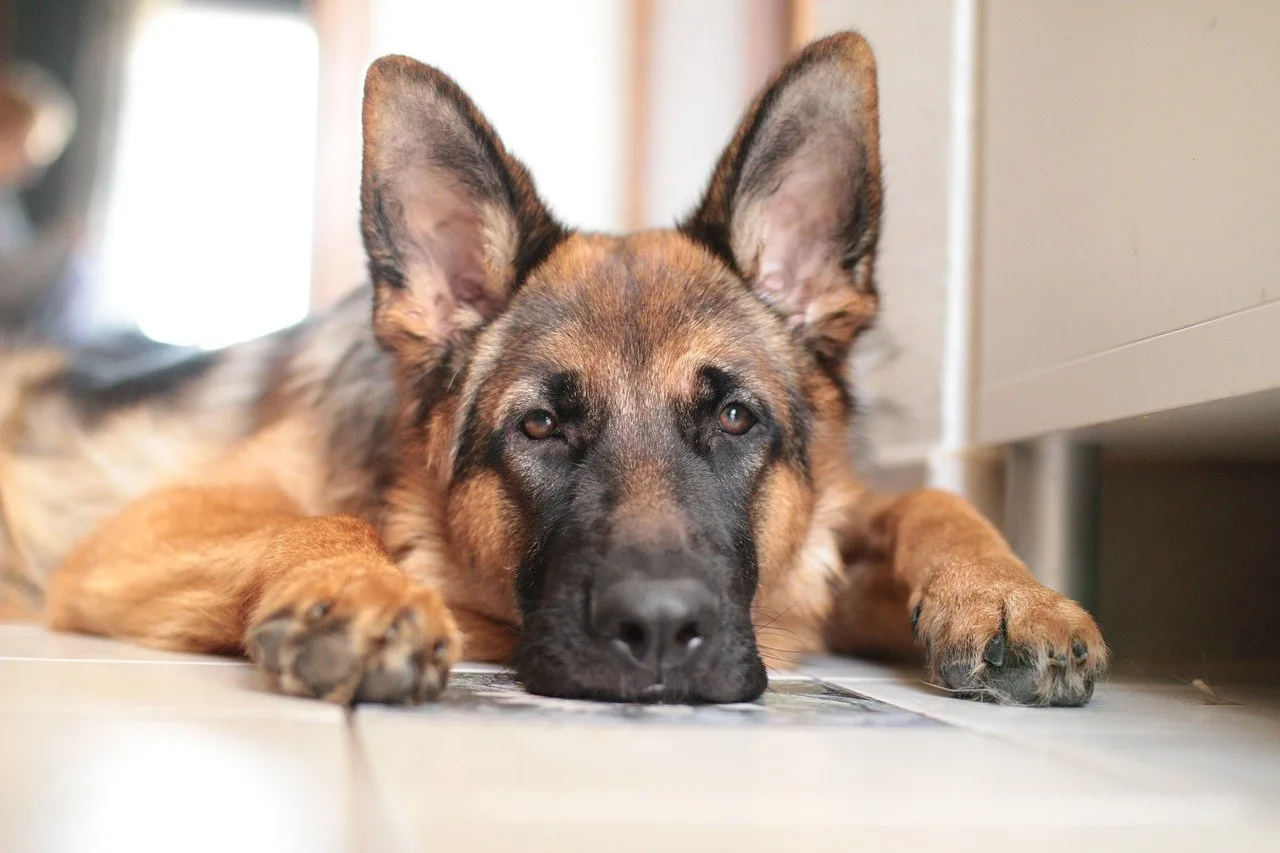
German Shepherds shed a lot. So, prepare yourself for dog hair everywhere, from your pants to the furniture. This also means you will have to brush your dog every day.
Generally, German Shepherds don’t smell bad and don’t get dirty easily, so they only need an occasional bath. Besides this, trim your dog’s nails every month if they don’t wear down naturally. You also want to take care of your go‘s teeth and keep gums healthy. Start brushing your Pastor Aleman‘s teeth when he is still a small puppy.
To stay healthy your dog needs high-quality, nutrient-rich food. Explore which food best suits your dog and stick with it. Also, don’t feed your dog table scraps as they can cause digestive issues and cause weight gain. Occasional healthy treats such as small quantities of dog-safe vegetables and fruits are ok. However, treats shouldn’t make up for more than 10% of the dog’s daily diet.
Conclusion on the Pastor Aleman
The German Shepherd is an amazing dog they excel at all the assistance work they have been trained to do. Just like Golden Retrievers and Labrador Retrievers. But to excel, they need a lot of training and care. So, despite being on the list of popular dog breeds, they might not be good for first-time owners. A dogs’ popularity doesn‘t guarantee an easy take care of the breed. In this case, the German Shepherd or Pastor Aleman will simply be too hard to deal with for a first-time owner.
German Shepherds need a firm hand. Someone who will let them know who the real Alpha and pack leader is. And, someone who knows how to train a dog the right way. They are known for their high intelligence, but they still need a lot of training including crate training.
This breed also might not be the best choice if you have small children. They might try to nip or herd your kid and are known for rough play. That’s another reason why they need an experienced owner. Also, teach your kid how to behave with the dog. Not only your dog how to behave with your child. Teach your kid that it’s not okay to pull the dog’s ears or tail.
Pastor Aleman is a big dog, so they need a lot of space too. It would be good if they had a yard where they can run around. But if not, if you live in a small apartment, you’ll have to take this herding breed out more and make sure they get around two hours of exercise a day.
But, one thing is sure, if you know how to handle this dog, it’ll become your best friend and companion.
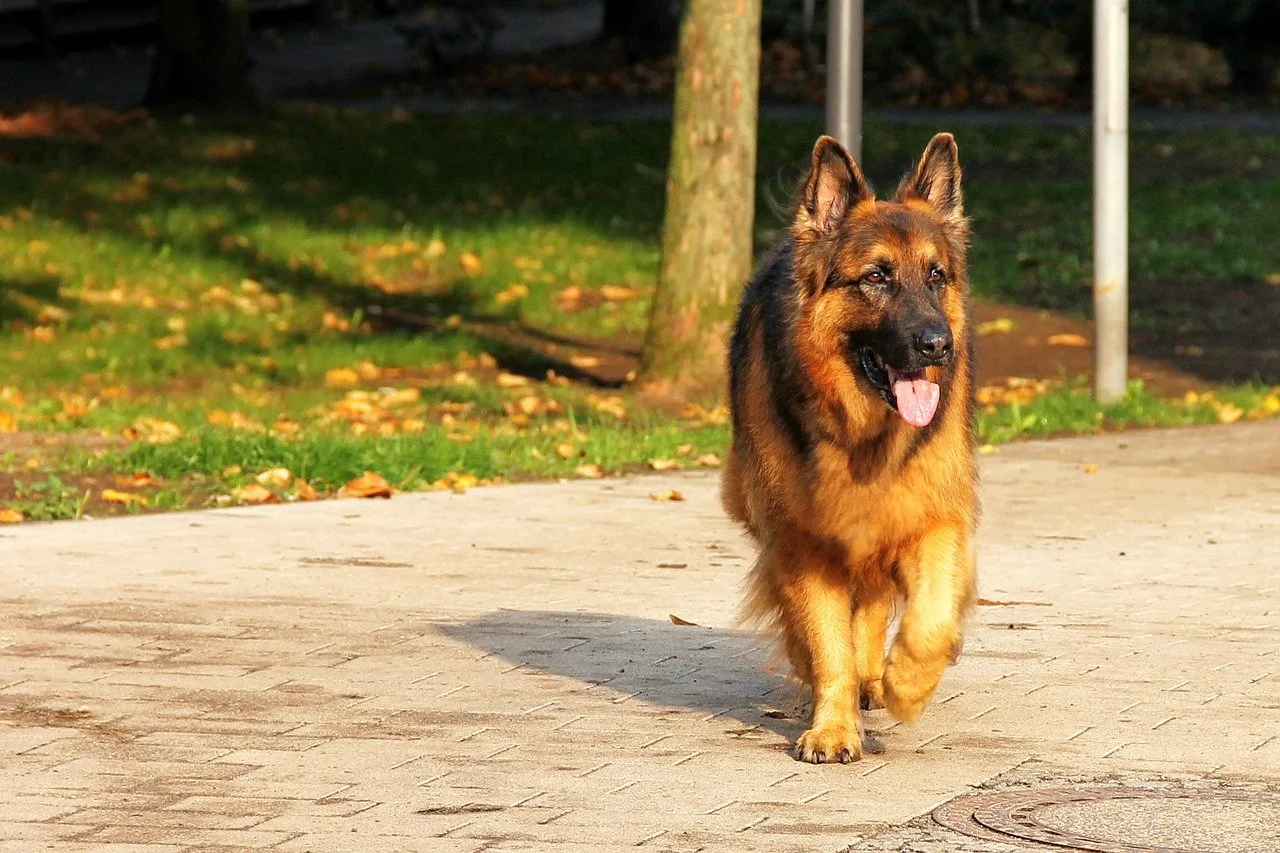
Pastor Aleman FAQ
What do most German Shepherds die from?
The two most deadly diseases that can affect German Shepherds are bone and spleen cancer.
What is bad about German Shepherds?
If you don’t socialize your Pastor Aleman, he can develop aggressive behavior. Also, German Shepherds demand lots of attention, exercise, and playtime and some people simply can’ satisfy their needs.
For how long can you leave German Shepherds alone?
German Shepherds are intelligent dogs that need plenty of physical exercises and mental stimulation. If they don’t get it, they will become bored and turn to destructive behavior. They can also develop separation anxiety. So, please don’t leave them alone for a long time.
You shouldn’t leave a Pastor Aleman puppy alone for more than one hour. And if you own an adult dog, don’t let them be alone for longer than four hours.

